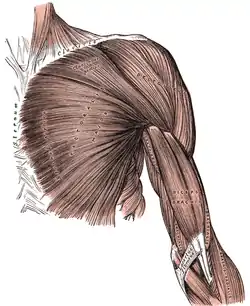Bicipital aponeurosis
The bicipital aponeurosis (also known as lacertus fibrosus) is a broad aponeurosis of the biceps brachii, which is located in the cubital fossa of the elbow. It separates superficial from deep structures in much of the fossa.
| Bicipital aponeurosis | |
|---|---|
 | |
| Details | |
| Identifiers | |
| Latin | aponeurosis musculi bicipitis brachii |
| TA98 | A04.6.02.016 |
| TA2 | 2467 |
| FMA | 39085 |
| Anatomical terminology | |
Structure
The bicipital aponeurosis originates from the distal insertion of the biceps brachii, and inserts into the deep fascia of the forearm.[1] The biceps tendon inserts on the radial tuberosity, and the bicipital aponeurosis lies medially to it.[2] It reinforces the cubital fossa, helping to protect the brachial artery and the ulnar nerve running underneath.[1][3][4]
Variations
Some individuals (about 3% of the population) have a superficial ulnar artery that runs superficially to the bicipital aponeurosis instead of underneath it. These individuals are at risk for accidental injury to the ulnar artery during venipuncture.[5]
Clinical significance
The bicipital aponeurosis is superficial to the brachial artery and the median nerve, but deep to the median cubital vein. This protection is important during venipuncture (taking blood).
It is one structure that has to be incised during fasciotomy in the treatment of acute compartment syndrome of the forearm and elbow region.
References
![]() This article incorporates text in the public domain from page 444 of the 20th edition of Gray's Anatomy (1918)
This article incorporates text in the public domain from page 444 of the 20th edition of Gray's Anatomy (1918)
- Morrey, Bernard F.; Llusá-Pérez, Manuel; Ballesteros-Betancourt, José R. (2018-01-01), Morrey, Bernard F.; Sanchez-Sotelo, Joaquin; Morrey, Mark E. (eds.), "2 - Anatomy of the Elbow Joint", Morrey's the Elbow and its Disorders (Fifth Edition), Philadelphia: Elsevier, pp. 9–32, doi:10.1016/b978-0-323-34169-1.00002-4, ISBN 978-0-323-34169-1, retrieved 2020-11-19
- Brown, Matthew; Chung, Kevin C. (2018-01-01), Chung, Kevin C. (ed.), "Procedure 87 - Biceps and Brachialis Lengthening", Operative Techniques: Hand and Wrist Surgery (Third Edition), Elsevier, pp. 771–777, doi:10.1016/b978-0-323-40191-3.00087-1, ISBN 978-0-323-40191-3, retrieved 2020-11-19
- Savastano, Luis; Yang, Lynda J. -S. (2015-01-01), Tubbs, R. Shane; Rizk, Elias; Shoja, Mohammadali M.; Loukas, Marios (eds.), "Chapter 41 - Anatomy of the Median Nerve and Its Branches", Nerves and Nerve Injuries, San Diego: Academic Press, pp. 553–562, doi:10.1016/b978-0-12-410390-0.00043-3, ISBN 978-0-12-410390-0, retrieved 2020-11-19
- Pezeshk, Parham (2015-01-01), Tubbs, R. Shane; Rizk, Elias; Shoja, Mohammadali M.; Loukas, Marios (eds.), "Chapter 13 - Imaging of Entrapped Peripheral Nerves", Nerves and Nerve Injuries, San Diego: Academic Press, pp. 167–171, doi:10.1016/b978-0-12-410390-0.00014-7, ISBN 978-0-12-410390-0, retrieved 2020-11-19
- Chin and Singh; Singh, K (2005). "The superficial ulnar artery--a potential hazard in patients with difficult venous access". British Journal of Anaesthesia. 94 (5): 692–3. doi:10.1093/bja/aei548. PMID 15814810.
External links
- Diagram at radsource.edu (seventh diagram from top)
- Anatomy photo:07:01-0201 at the SUNY Downstate Medical Center - "Flexor Region of the Forearm: Muscles that Border the Cubital Fossa"